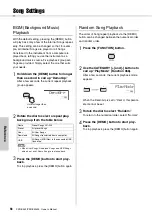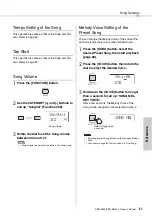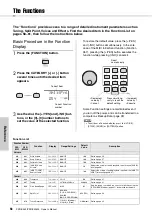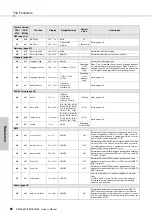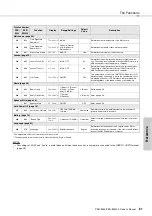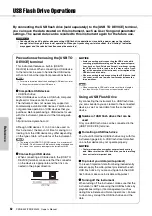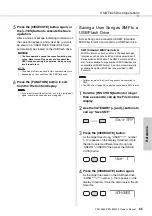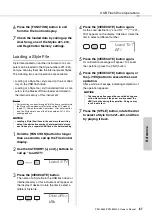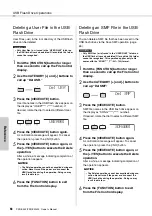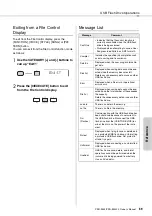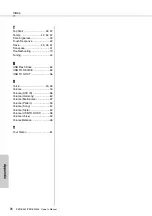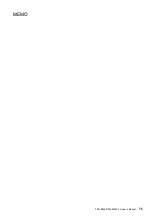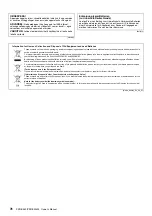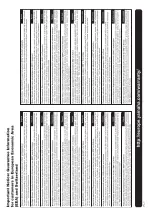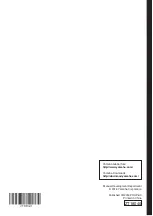
PSR-E453/PSR-EW400 Owner’s Manual
70
Appendix
Troubleshooting
Refer to the “Message List” on page 69 as required.
Problem
Possible Cause and Solution
When the instrument is turned on or off, a popping
sound is temporarily produced.
This is normal and indicates that the instrument is receiving electrical
power.
When the instrument is turned on, power is turned off
suddenly and unexpectedly.
This is normal. If an AC adaptor other than the one specified is used,
power may be turned off suddenly and unexpectedly.
When using a mobile phone, noise is produced
Using a mobile phone in close proximity to the instrument may pro-
duce interference. To prevent this, turn off the mobile phone or use it
further away from the instrument
The instrument is automatically turned off even if no
operation is done.
This is normal. This occurs due to the Auto Power Off function (page
16).
• The volume is too soft.
• The sound quality is poor.
• The Style/Pattern/Song/Arpeggio stops unexpectedly
or will not play.
• The recorded data of the song, etc. does not play cor-
rectly.
• The LCD display suddenly goes dark, and all panel
settings are reset.
• The instrument turns off when a USB flash drive is
connected.
The batteries are low or dead. Replace all six batteries with completely
new ones or completely recharged ones, or use the AC adaptor.
No sound is produced even when the keyboard is
played, or a Song, Style, or Pattern is being played
back.
Check whether a set of headphones or an audio cable is connected to
the [PHONES/OUTPUT], or not. When such a connection is made, no
sound is output from the speaker of this instrument.
(PSR-EW400) Check the on/off status of the Speaker Mute setting
(page 38). Make sure to set to OFF.
Check the on/off status of the Local Control (page 61). Normally, set
this parameter to ON.
The footswitch (for sustain) seems to produce the
opposite effect. For example, pressing the footswitch
cuts off the sound and releasing it sustains the sounds.
The polarity of the footswitch is reversed. Make sure that the foot-
switch plug is properly connected to the SUSTAIN jack before turning
on the power.
No sound is produced even when playing keys in the
right hand area of the keyboard, although chords
played in the left hand area are recognized.
Check whether or not the Dictionary function (page 55) is used. When
used, this is normal.
Not all of the Voices seem to sound, or the sound
seems to be cut off, when playing the keyboard,
Arpeggio, Style or Pattern or Song.
You have exceeded 48 simultaneous notes, which is the maximum
polyphony (the maximum amount of notes that can be played simulta-
neously) of this instrument. If the Main, Dual, and Split Voices are
being used along with playback of Arpeggio, Style, Pattern or Song,
some notes/sounds may be omitted (or “stolen”).
The sound of the Voice changes from note to note.
This is normal. The tone generation method uses multiple recordings
(samples) of an instrument across the range of the keyboard; thus, the
actual sound of the Voice may be slightly different from note to note.
The keyboard performance and playback of Style/Pat-
tern/Song produces an unexpected or inappropriate
sound, and cannot be restored to the normal status.
Using the Knobs can produce dramatic changes in the sound, but may
also produce unexpected or undesired sounds. If you want to restore the
original, normal sound before being changed by the Knobs, press the
[DSP] button to turn DSP off, change the Voice, Style, Pattern or Song,
or press the [PORTABLE GRAND] button to reset the panel settings.
The Style, Pattern or Song does not start even when
the [START/STOP] button is pressed. The Arpeggio
does not start even when the note is pressed with the
Arpeggio turned on.
Check the on/off status of the External Clock (page 61). Normally, set
this parameter to OFF.
The volume of the Style, Pattern or Song is too low.
Check the volume setting in the Functions (pages 53 and 57).
The chords played in the left hand area cannot be rec-
ognized even when ACMP is turned on.
Check the Split Point setting (page 53). Set this to an appropriate
value.
Style parts other than the Rhythm part produce no
sound.
Check the on/off status of the ACMP (page 26). Make sure to turn
ACMP on.
The ACMP indicator does not appear on the display
when the [ACMP ON/OFF] button is pressed.
Check the on/off status of the [STYLE] lamp. When using a Style,
press the [STYLE] button to turn on the [STYLE] lamp.
Appendix
Summary of Contents for PSR-EW400
Page 75: ...PSR E453 PSR EW400 Owner s Manual 75 MEMO ...
Page 78: ......

